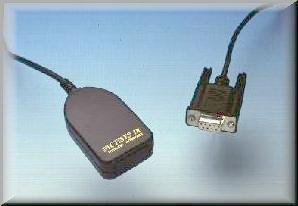|
IR 220LN: Instantly Covert RS232
Cable to IR, Without Special IR SW!
No SW
Modification Required: Single IR Speed Using IR220LN
You may use
exactly the same RS232 protocol software you have now if you
use one each of IR220LN on each side of the two communicating
devices. You can select one of the following IR speeds; 9.6K,
19.2K, 38.4K, 57.6K, 115.2K bps as fixed IR speed for your
application.
Replace
RS232 Serial Cable with IR
ACTiR-220L/L+
may be used to replace the RS-232 cable without IrDA protocol
if the following restrictions are applied: |


|
|
(a) DTR and RTS must be used to power the IR220L/L+ and to
set up the data rate as described in (3) and (4) above. They
cannot be used for handshaking, flow control, or other
proposes.
(b) IR220L/L+ will automatically block the receiver when it is
transmitting. However, it is prudent to flush the receiver
register, FIFO, and/or buffer when switching from transmitting
to receiving.
(c) Full-duplex operation is not possible. XON/XOFF software
flow control cannot be used. (This is due to the fact that the
transmitting party cannot receive the XOFF while it is
transmitting.) Other kind of half-duplex compatible software
flow control (or no flow control at all) must be used.
(d) Error rate will depend on the ambient EM and light noise
level. IR path may also be blocked accidentally by the user.
Software error checking and recovering are recommended.
Details of
it and implementation example are available from ACTiSYS.
You May
Modify RS232SW to Get Multiple IR Speeds: IR220L/L+
Programming
ACTiR 220L or
IR220L+ is a serial port IR converter for IrDA-1.0
(9.6K-115.2Kbps). It converts RS-232 serial signals to/from
IrDA Physical Layer compliant IR signals. Programming Guide is
available.
ACTiR-220L:
9.6, 19.2, 57.6, 115.2K bps. ACTiR-220L+: 9.6, 19.2, 38.4,
57.6, 115.2K bps
Pin 1: NC
Pin 2: RxD (Received serial data) going to the host. Active
+5V, inactive 0V (this is not RS-232,
but is compatible with most RS-232 receivers in the host).
Pin 3: TxD (Transmit serial data) from the host. Active +7 to
+15V, inactive 0 to -15V (RS-232).
Pin 4: DTR (Data terminal ready) from the host. Active +7 to
+15V, inactive 0 to -15V(RS-232).
Pin 5: Gnd (signal ground), Pin 6: NC
Pin 7: RTS (Request to send) from the host. Active +7 to +15V,
inactive 0 to -15V (RS-232).
Pin 8: NC, Pin 9: NC |
